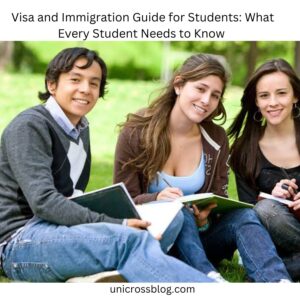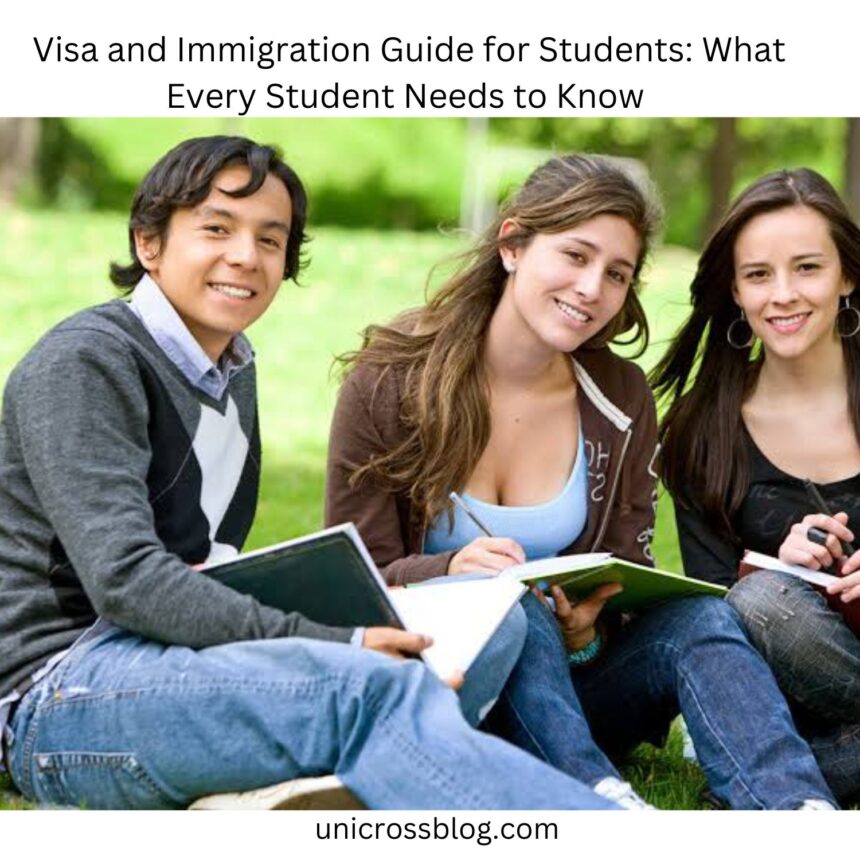Visa and Immigration Guide for Students: As an international student, you have a lot to consider when planning your study abroad experience. One of the most important things is making sure you have the proper documentation to legally enter and remain in your host country. Immigration policies can be complex, but understanding the basics of student visas and the application process is essential. Failure to obtain the correct visa can derail your plans before you even depart.
However, with some advanced preparation, you can navigate the requirements confidently. This guide provides an overview of common student visas, eligibility criteria, application materials, processing times, and restrictions.
Following the steps outlined will help ensure your documentation is in order so you can embark on this exciting new chapter of your life with peace of mind. The opportunity to study in another country can be life-changing, so make the most of it by starting with a solid understanding of the legal details. With the right knowledge and preparation, you’ll be well on your way to an unforgettable experience.
Types of Student Visas

To study in the U.S. as an international student, you will need to obtain a student visa. The three primary visa types are:
1. F-1 Visa
The F-1 visa is the most popular visa for international students in the U.S. It allows students to study in academic or language programs. To qualify for an F-1 visa, you must be enrolled full-time at a school that is accredited and authorized to accept international students.
You must also show that you can pay your tuition and living costs. The F-1 visa offers benefits such as the ability to work on-campus, participate in Curricular Practical Training (CPT) during your studies, and engage in Optional Practical Training (OPT) after graduation. This visa is essential for students looking to gain valuable experience while studying in the United States.
2. J-1 Visa
The J-1 visa is intended for students in exchange visitor programs. It promotes cultural exchange and provides valuable training experiences. To qualify, applicants must be sponsored by an authorized exchange program and show they have enough funds to support themselves.
Employment is only allowed if it relates to the applicant’s field of study. Additionally, after completing the exchange program, J-1 visa holders must return to their home country for two years before they can apply for an H-1B visa or a green card. This visa is an excellent option for those seeking to broaden their education and work experiences while immersing themselves in a new culture.
3. M-1 Visa
The M-1 visa is designed for students attending vocational or technical schools. Applicants must enroll in programs that offer practical training and demonstrate sufficient financial resources to cover their expenses. An M-1 visa does not allow for employment, except in limited circumstances related to training. Students can stay in the U.S. for a maximum of three years.
READ ALSO: Top Destinations for Studying Abroad
Eligibility Requirements for Student Visas
To be eligible for a student visa, you must first meet the admission requirements for your selected school or program in the host country. The specific eligibility criteria will depend on the type of student visa you need, based on your course of study.
F-1 Visa
To qualify for an F-1 visa for undergraduate or graduate study at a college or university, you must:
- Be enrolled in a full-time program at an accredited institution
- Show proof of sufficient funds to cover tuition and living expenses for at least one year of study. The school will provide an I-20 form to include with your application.
- Meet any language proficiency requirements for your program. Some schools may require English language testing for non-native speakers.
- Have a permanent residence abroad to which you intend to return after your studies.
J-1 Visa
For J-1 visas, which cover exchange programs like study abroad, work-study, internships, or research programs, the eligibility criteria are:
- Be enrolled in an exchange program through an approved sponsor organization
- Have at least two years of education or work experience in your field of study or research
- Meet any language proficiency or funding requirements for your specific exchange program
- Intend to return to your home country for at least two years after the exchange program ends
M-1 Visa
You must meet the following requirements in order to apply for an M-1 visa:
- You need to be a full-time student in a vocational or other non-academic school.
- You must speak and write English very well, or you must be taking English classes.
- You must be able to pay for your own expenses during your stay and have a home outside of the United States.
- The Student and Exchange Visitors Program (SEVP) has to agree to your plan.
The Student Visa Application Process Step-by-Step
The process for applying for a student visa typically involves several steps. To ensure your application is approved, be prepared by understanding the requirements and having the necessary documents ready.
1. Check visa requirements
The specific requirements to obtain a student visa will depend on the country you plan to study in and the length of your program. In most cases, you will need to provide proof of enrollment in an accredited institution, evidence of sufficient funds to cover tuition and living expenses, a valid passport, and possibly additional materials. It is best to check with the embassy or consulate of your destination country for their precise requirements.
2. Gather required documents
In addition to a valid passport, the key documents typically include:
- Acceptance letter from the institution you plan to study at
- Evidence of financial support for tuition and living costs (bank statements, scholarships, etc.)
- Completed visa application form
- Two passport-size photos
- Transcripts and diplomas from previous schools attended
- Standardized test scores (if required for admission)
- Accommodation arrangements (housing contract, lease, etc.)
Having a well-organized file with originals and copies of all these materials ready ahead of your interview will help ensure a smooth application process.
3. Schedule your interview
Once you have determined you meet the requirements and have gathered the necessary documents, you must schedule an interview appointment with your local embassy or consulate. Wait times for interviews can vary, so check with them directly and book your appointment as early as possible.
4. Attend your interview
Arrive for your interview a few minutes early and be prepared for questions about your intended course of study, financial situation, and future plans. Dress professionally, be polite, and provide honest responses to establish your credibility and intentions as a serious student. Your supporting documents will also be reviewed to validate the information you provide.
5. Receive your visa
If your application and interview are successful, your student visa will be issued. The process typically takes between a week to a couple of months. Once received, check to ensure all details on the visa are correct before making any final arrangements to commence your studies abroad!
Maintaining Valid Immigration Status While Studying
As an international student, it is critical to maintain a valid immigration status for the duration of your studies. Failure to do so could result in serious consequences like deportation or banishment from re-entering the U.S. The following steps will help ensure you remain in legal standing:
1. Enroll as a Full-Time Student
You must register for and complete a full course of study during each academic term to maintain F-1 or M-1 status. This typically means enrolling in at least 12 credit hours per semester for undergraduate students and 9 credit hours for graduate students. Reduced course loads must be approved by your Designated School Official (DSO).
2. Limit On-Campus Employment
F-1 and M-1 students are allowed to work part-time on campus for up to 20 hours per week while school is in session. Make sure any on-campus job does not interfere with your studies. Off-campus employment requires additional authorization.
3. Do Not Overstay Your Visa
Pay close attention to your Form I-20 or DS-2019, which specifies your program end date. You must depart the U.S. within 60 days of completing or terminating your program of study. Overstaying your visa can lead to serious penalties and jeopardize future entry.
4. Report Address Changes
You must inform your DSO within 10 days of moving to a new address. Your SEVIS records must always contain your most current physical address, email address, and phone number.
5. Limit Trips Abroad
While enjoying periodic trips outside the U.S. is permitted, extended absences can be problematic. As a general rule, limit trips to less than 5 months per academic year. Always check with your DSO before traveling to ensure you have proper documentation for re-entry.
Conclusion
As a student, you must understand immigration regulations and the necessary steps to secure proper documentation for your studies abroad. Do your research, plan well in advance, and stay up-to-date with any policy changes that could impact your status. While the process may seem daunting, approaching it systematically and maintaining clear communication with the relevant authorities will help ensure your paperwork is in order.
This is UnicrossBlog, Offering Curative and Creative Writing. Do well to visit other of our Articles.








